Great Migration#
by Sergey Semenov and Stas Sedov,
members of the AirPano Team that is a member of the global-geography Consortium.
6 November 2013
with kind permission of AirPano
After long preparations, including dozens of test flights and experiments, it was time to pack our bags and backpacks. Finally, from the side window in the haze of dawn we saw Nairobi, the capital of Kenya.
One day for acclimatization and another day to get to the park — time flew by very fast. The only thing that was giving us the jitters was the thought that it would be a very unusual shooting session. Our task was to shoot an amazing phenomenon — a crossing of thousands of animals across the Mara River in Africa during seasonal migration, which is the dream of any animalist photographer. In the past we took a lot of pictures of different wonders, both natural and man-made, but taking pictures of fast running animals with radio-controlled helicopter was very new to us.
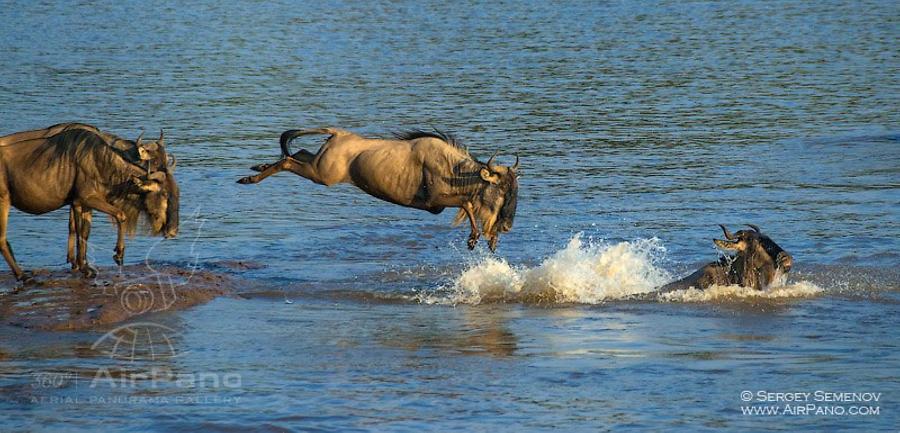
In the evening we arrived to the camp situated on the border of the Masai Mara National Reserve. Before sunset we took our equipment and went to test it on a clearing not far from the "cafeteria". Camp guards were curiously observing our preparations for the launch. When everything was ready, we turned on the power and started the shooting. Suddenly we heard a strange sound: a young Masai, probably amazed or frightened, leaped to the side and hit the nearest tree.
In the morning before dawn we left the camp in search of wildebeests. Almost immediately we encountered a small hippopotamus. Five minutes later we saw a hyena, then a she-elephant with her baby standing next to the road, and a few giraffes in the distance. When we entered the park a lonely lion crossed the road right in front of our car. It was a very interesting start of the day! And a vivid one!
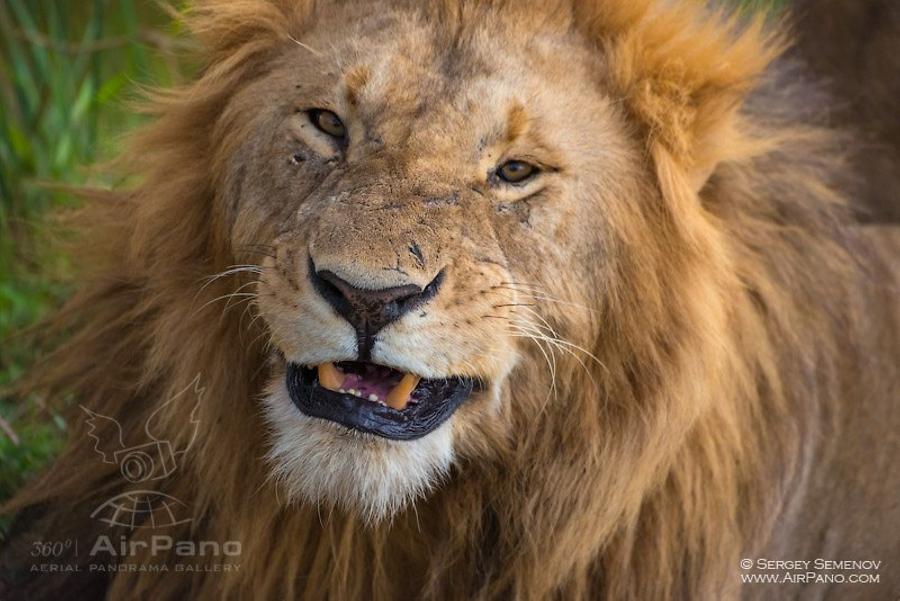
There aren't many crossing points across the river for animals in the reserve: the shore line is quite steep with very few slopes leading to the water. There are even fewer places with slopes on both sides of the river. Our guides took us to the main crossing point. There were hippos and crocodiles splashing in the river, and a lot of vultures and marabou on the shore. There were also dozens of wildebeests' corpses in the water: they died during the crossing. You can imagine the nasty smell in that area.
It should be noted that most animals die during the crossing not because of crocodiles and hippos. They crush each other to death trying to get to the other side of the river. Those who fall down on slippery rocks and break their legs are eaten by hyenas at night. It's places like these that remind you of cruel "law of the jungle", where the strong always eats the weak.

We were unlucky in our attempts to take pictures of animal crossing. Despite of dry season it rained almost every day: the sky was gray and cloudy. Animals crossed the river not as a solid mass, but mainly in small groups. All of that was a bad surprise. It was difficult to tell where and when the crossing would take place, but even if our guides correctly identified the location it was almost impossible to catch the moment when wildebeests were crossing the river.
The problem was that animals could be easily frightened: if they saw a man or a car nearby they wouldn't cross the river and would wait it out or go look for another crossing spot. Every day we would sit for 6-8 hours hiding half a kilometer away from the selected animal areas and wait for the wildebeest ritual, which precedes the first jump to the water, to be over.
The ritual was as follows: a few animals would separate from the herd and go to the water. They would sniff the water and go back to the herd, after that they would go the water again. That ritual was repeated several times until one of the antelopes jumped into the water. All the others would rush after it. Sometimes, during the "approach" phase one or two antelopes that crossed the river a day earlier would call out to their brethren from the other side. It looked very strange, as if the animals were talking to each other. Our guides called it "the singing": if a wildebeest started to "sing" you could expect the crossing to begin.
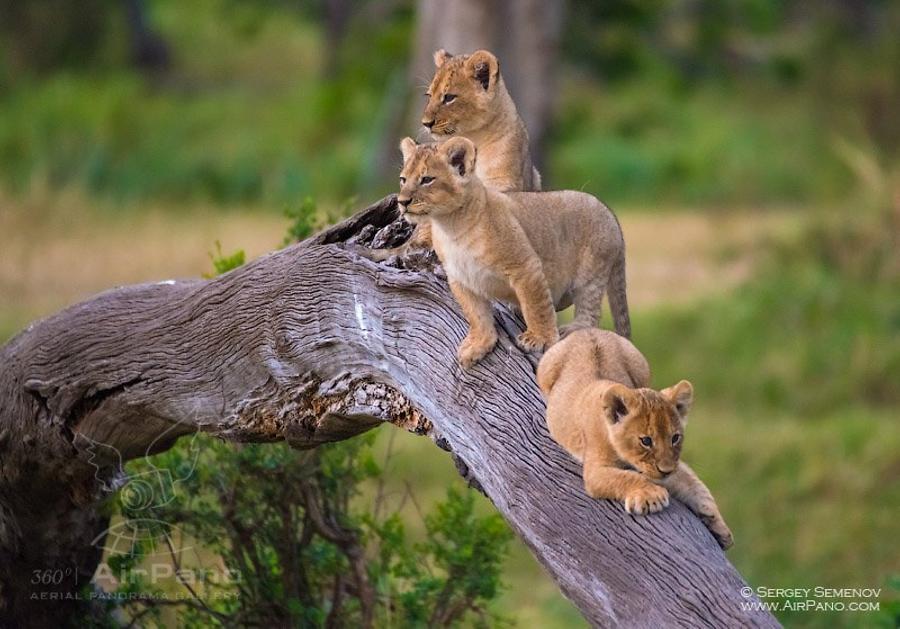
When first wildebeests jumped into the water, it was time for us to act. While our jeep raced over the bumps to a pre-selected location, I, like a real trooper, went out the hatch in the roof and launched the helicopter. And, as a rule, we were only able to shoot the end of the crossing: there were very few animals and they crossed the river very fast.
But more often the crossings were interrupted. Imagine how we felt after 6 hours of sitting in the car (it was strictly prohibited to leave the car in the park) when we saw that animals were about to go. They already began sniffing the water, and it seemed like they would jump in. At that very moment 2-3 cars with curious tourists drove up to the wildebeests on the opposite bank of the river. The animals got scared and changed their mind: the show was cancelled. Tourists didn't care, because they didn't sit here for hours waiting for the right moment, they just moved on after waiting for half an hour. At that moment we felt so much hatred for narrow-minded drivers that ruined our shooting session.

The problem of the Masai Mara National Park is that practically anyone can enter it. All you need is a ticket and a car. Because of that the park is overcrowded during the season. It's hard to observe rare animals: if someone found, for example, a family of lions in the Bush (an African forest with short trees), 15-20 cars would immediately drive up to that location. Animals would get nervous and go away. And it's very hard to take pictures in those conditions.
It gets even worse with wildebeests. They get scared more easily than lions, and most drivers in the park don't understand wildebeest habits and because of that they ruin experience for their passengers and passengers of professional drivers. During that week in the park wildebeest crossings were interrupted by people or took place at night when no one was around (the park closes around 7 pm).

Another problem was noise made by the tourists. Even if rangers managed to organize things by placing cars at some distance from the crossing spot, not all tourists could keep silence. The Chinese were especially bad in that regard. They just couldn't talk to each other in low voice. I had a strong urge to take my tripod and smash it against the roofs of nearby cars, so that people could finally understand the importance of silence during the waiting period.
While we were looking for a crossing, there was an incident that could have ended in tragedy. We were taking pictures of giraffes somewhere in the central area of the park. Giraffes were one of the few animals that weren't afraid of our helicopter, allowing us to fly up to them very closely. While we were doing that a lone elephant came out of the Bush. Elephant is one of the most dangerous animals in the Masai Mara National Reserve. If you somehow anger an elephant, the only way to escape it is by car. Climbing trees or hiding under rocks won't help you! The elephant will not rest until it gets you.
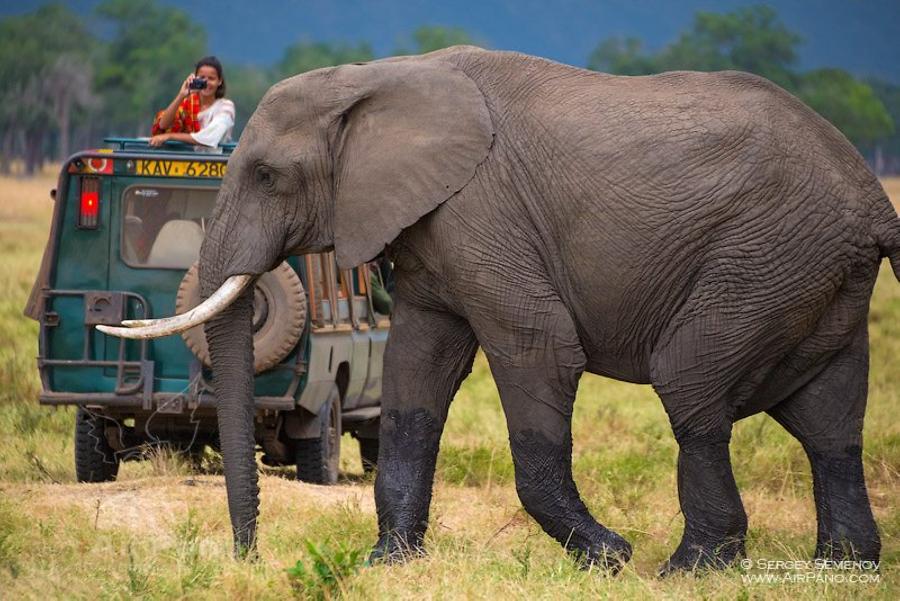
A large lone elephant was heading in our direction. Even then Duo, one of our guides, said that he didn't like the way elephant was walking. Duo just stated his concern. At that moment Sergei and I were busy shooting a group of giraffes 200 meters away from the car. Elephant was coming straight at us. He stopped a hundred meters from the car and started to sprinkle his head with dust by using his trunk. When Duo saw that he shouted that we needed to leave immediately, because it seemed that the elephant would attack us.
"But what about the helicopter?" I asked (the helicopter was in the air).
"Forget the helicopter! Run for your lives!"
I gave up control, leaving the helicopter hanging in the air over giraffes, and dove into the hatch. "Evans, Go!" Duo and I shouted to our driver. But for some reason Evans didn't go forward, but backwards towards the elephant. Then we screamed at him all at once! Evans woke up and pulled the lever to the first gear. The car drove off the trajectory of the elephant. When elephant saw us leaving he stopped chasing us and switched his attention to the tourist car that was standing nearby. After driving a couple of hundred meters away we finally took a breath. And what happed with helicopter? Helicopter was patiently hanging in the air on autopilot right where I left it. I went out the hatch and, taking control with my shaky hands, landed the helicopter before battery died. It turned out well in the end and everyone, except for cold-blooded Sergei Semyonov, were sweating from adrenaline rush.
However, the realization of the possible danger came to us only the next day when our guides told us that the lone elephant killed a local from a nearby village at night.

That whole week we were still shaken up by that event. We were able to capture some small-scale wildebeest crossings, but weren't happy with the results. It was our last day. Our plans were almost ruined and we couldn't stay in Masai Mara any longer. But that day luck was finally on our side. At the crack of dawn a huge herd of wildebeest came to the river. Pro drivers and rangers were able to organize a steady line of more than a hundred of tourist cars. Everyone was waiting in anticipation.
The head of the herd approached the river and began a standard ritual of sniffing and going back and forth. But then one of the drivers lost his cool and drove to the river: he triggered a chain reaction and everyone rushed after him. A group of noisy cars was approaching a herd of animals. At that moment I was sitting on the roof of our jeep, trying not to lose our helicopter on a shaky road. It was exciting: it reminded me of a helicopter attack scene from Platoon movie by Oliver Stone. But in the end it was very disappointing. Cars ran into a herd of wildebeests, but there was no first jump into the water, and the grand crossing of the season didn't happen. Animals looked at the people for a couple of minutes, turned around and went away from the river.

What a bummer! No, really, it was such a bummer! And all because of one impatient blockhead. However, our guides told us that they noticed some signs that the crossing could still happen, but at a different location that most tourists don't know about. We and a few other cars with experienced drivers turned around and headed to the new location. Later other tourists came there too. The order in a new line of cars was controlled by rangers. Besides a stone field prevented cars from moving to the antelopes.
And it finally happened! After the first jump and a trail of gray bodies jumped into river. We missed the first part of the crossing though. If the sound of our helicopter frightened animals, we would be killed on the spot. So we started taking pictures a few minutes later. However, the noise from a passing herd of animals was so loud that we didn't even hear the sound of our helicopter.
And it was a grand spectacle: according to our guides, a week of searching and waiting in savannah allowed us to witness the most massive and lengthy animals crossing of the entire season 2013. Now you can see it with your own eyes through our virtual tour published today.
And now a few facts about the antelope migration in the Masai Mara National Reserve.
Masai Mara, a unique nature reserve, is located in the south-western part of Kenya, with its northern part adjoining the Serengeti National Park. The reserve was named after the indigenous population (Maasai) and the Mara River.
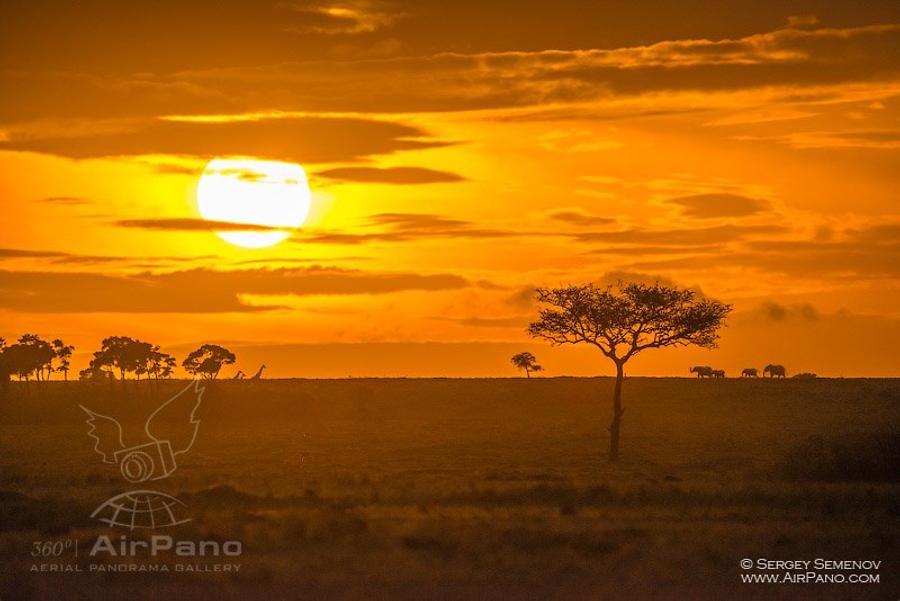
With an area of 1510 square kilometers, Masai Mara is one of the largest nature reserves in Kenya. For the most part the reserve landscape consists of a grassy savannah with acacia trees. The western border of the Masai Mara is formed by one of the slopes of the rift valley. This swampy area, thanks to the abundance of moisture, is a home to many animals.
The main pride of Masai Mara is "big five" (the most famous African animals: lion, elephant, rhino, buffalo and leopard) . The Mara and Talek rivers are a home to crocodiles and hippos. There are also cheetahs, zebras, hyenas, giraffes, gazelles, and other wild animals. 450 species of birds live in the reserve.
Masai Mara is also home to the largest population of wildebeests: we are talking about millions of species. Every year, around July, huge herds of these animals migrate from the dry plains of the Serengeti to the north in search of fresh grass, and in October they return to the south
On their way to Kenya they cross two rivers in the Serengeti: Mbalageti and Grumeti. Usually these rivers are calm, but when rainy season starts they become full-flowing, which is a challenge for migrating animals.
However, the ancient instinct drives antelopes so much that they are willing to overcome all obstacles. They can't be stopped by fast flowing rivers, lions, crocodiles, and other predators.

During their long journey wildebeests traverse 3000 kilometers. Scientists estimate that millions of these animals require 4,000 tons of grass on a daily basis.
Unfortunately, many animals die during the migration. The last and most difficult obstacle for them is the Mara River in Kenya. Wildebeests gather near the shore, choosing the most convenient place to cross the river. Every year they choose a new crossing spot, because water level and other factors can be different each time.
This choice may take a few days, but it's not always the right one. The perfect crossing spot should have a steady flow and a shore free of any vegetation. But sometimes wildebeests choose "suicidal" crossing spots with hundreds of them dying in the process.
But let's not talk about that! In late October with the start of short rains that fill up local water bodies in the Seregeti, satisfied and full wildebeests start moving south again. They follow the same path; about 90 % of female wildebeests are pregnant at that time.
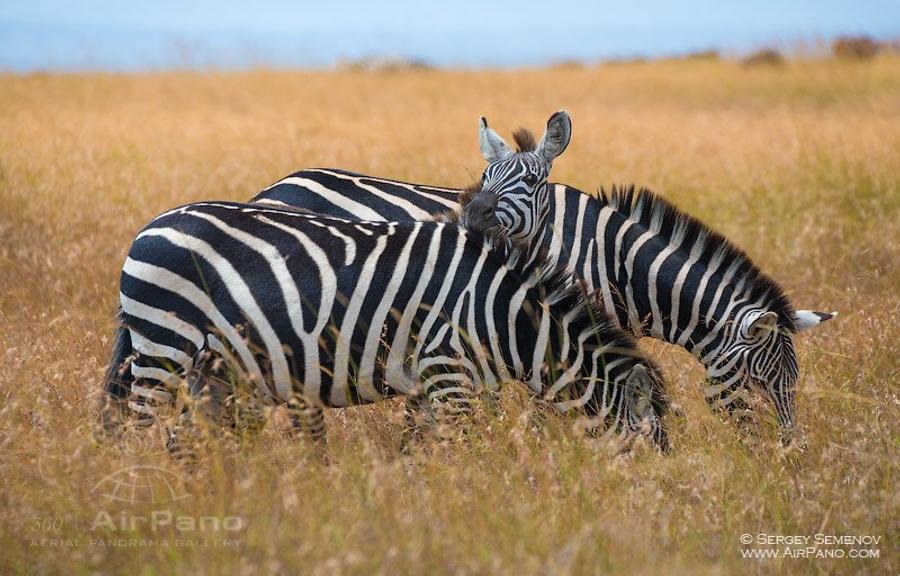
After returning to the Tanzanian Park a new life cycle begins for wildebeests: female wildebeests give birth to a quarter of a million calves who, just like their ancestors, will hit the road next summer for the succulent grass of the Masai Marai National Reserve.
12 Panoramas of Great Migration